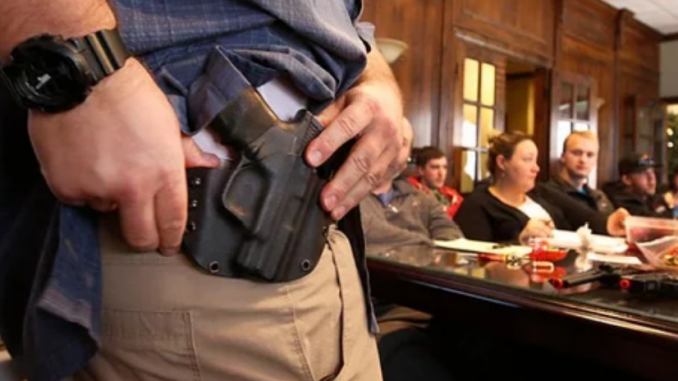
By now, there’s enough evidence to confirm that openly carrying a gun can make you a target for a gun grab. Therefore, if you want to open carry, it’s up to you to manage that risk. How that’s done is with an active retention holster.
While alarmists in comments sections and social media make it sound like it happens all the time, reality is more like “it happens from time to time” rather than every day.
For instance, a women open carrying in a Walmart in Radcliffe, Ky., had her gun stolen from her holster as she reached for an item on a high shelf in mid-April. Someone grabbed her gun and made themselves scarce.
In January, a man open carrying in Detroit stopped in a gas station, and had his gun taken right out of the holster as he was talking to the cashier. Luckily, the thief was caught, thanks to the surveillance footage.
So, if you’re going to open carry out and about in public, the typical open-top OWB isn’t secure enough.
“Active retention” is so-called because it has a mechanical safety feature, a device that you have to deactivate in order to get the gun out of the holster. Some have more than one.
The earliest examples, such as the Threepersons holster, were a simple strap over the gun with a snap or a hammer loop. Over time, new devices were added such as the Bianchi thumb strap, which became the dominant form of active retention device until the advent of the modern duty holster.
Active retention holsters are standard-issue for police officers and military personnel who carry a handgun, and for the same reason that a citizen open carrying should wear one. It keeps the gun securely in the holster, both for walking around and doing whatever you’re doing and also in case of a gun grab.
Now, active retention holsters are made in “levels.” There are a couple of different definitions of retention levels, but the commonly-used definition is where adding a new retention device is one extra level of retention.
The typical open-top holster is Level I, a holster with one active retention device (such as a thumb break strap) is Level II, adding a second active retention device is Level III and so on.
Currently, the greatest amount of retention you can buy is a Level IV, which is available from Safariland.
Most police officers and military personnel carry with a Level II or Level III holster, which will more than suffice for the armed citizen.
Okay, great. So how do you buy one that’s actually good?
First, prepare to invest a little. Rarely is an active retention holster very good that is also inexpensive.
Avoid cheap nylon holsters like the plague. The retention device is awful, and they’re cheap for a reason. They’re fine as a sleeve if you want to store your gun in a safe, but not to carry with. Just don’t.
Good materials are either quality leather or a hard molded polymer such as Kydex or molded nylon. The holster has to have some durability for obvious reasons, and the trigger guard has to be fully enclosed and protected. Any holster that allows manipulation of the trigger is unacceptable.
As to what retention level you want, that much is up to you. Level II or Level III are both fine for daily carry purposes. What matters more is the retention device itself.
So, what you’re looking for is a retention device (or devices, if opting for a Level III holster) that are reasonably easy to manipulate for you to manipulate, without compromising safety or security.
You want to be able to operate the holster under stress, so the retention devices can’t make that difficult, or for that matter unsafe, and they have to be actually effective.
Straps that attach on the holster body itself are right out. As cool as an old Threepersons’ rig is, the snap can be undone by someone else with relative ease. This is another reason to avoid the cheap nylon holsters you find in gun stores.
The fewer motions needed to deactivate the active retention, the better.
Retention devices to look for are an ejection port lock and/or a locking backstrap. These are generally the most secure and cause the least amount of problems in practice.
Any active retention holster that requires you use the trigger finger to deactivate the retention device is to be avoided. It creates a possibility of the trigger finger slipping into the trigger guard while drawing, which increases the risk of negligent discharge.
Avoid the Serpa. Just say no.
Some guns come with a Serpa clone holster in the box. Say no to those too.
In fact, let it be spelled out here: The standard for active retention holsters at the moment is the Safariland ALS.
If you’re considering open carrying on the regular, the ALS or a similar holster design is going to be your best bet in terms of defending against a gun grab.
Open carry is a hot potato in the gun community. Everyone has an opinion on it one way or another, and it’s up to you to figure out what your thoughts about it are. Feel free to sound off in the comments.
Besides the typical talking points about open carrying, what’s obvious and objectively true is that there are real incidents where someone open carrying has their gun taken. Therefore, it’s a good idea to figure out what’s the best way to open carry if you’re going to.
Where that starts is with an active retention holster of sufficient quality to securely retain the pistol.
The next step is to train with it, because it’s pointless to have gear you can’t operate under stress.
Sam Hoober is a hunter and shooter based in the Inland Northwest.
*story by The Daily Caller
